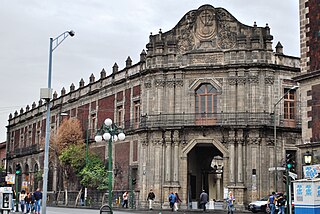 W
WThe Mexican Inquisition was an extension of the Spanish Inquisition to New Spain. The Spanish Conquest of Mexico was not only a political event for the Spanish, but a religious event as well. In the early 16th century, the Reformation, the Counter-Reformation and the Inquisition were in full force in most of Europe. The Catholic Monarchs of Castile and Aragon had just re-conquered the last Muslim stronghold in the Iberian Peninsula, the kingdom of Granada, giving them special status within the Roman Catholic realm, including great liberties in the conversion of the native peoples of Mesoamerica. When the Inquisition was brought to the New World, it was employed for many of the same reasons and against the same social groups as suffered in Europe itself, minus the Indians to a large extent. Almost all of the events associated with the official establishment of the Holy Office of the Inquisition occurred in Mexico City, where the Holy Office had its own "palace", which is now the Museum of Medicine of UNAM on Republica de Brasil street. The official period of the Inquisition lasted from 1571 to 1820, with an unknown number of victims.
 W
WThe Tribunal of the Holy Office of the Inquisition, commonly known as the Spanish Inquisition, was established in 1478 by Catholic Monarchs Ferdinand II of Aragon and Isabella I of Castile. It was intended to maintain Catholic orthodoxy in their kingdoms and to replace the Medieval Inquisition, which was under Papal control. It became the most substantive of the three different manifestations of the wider Catholic Inquisition along with the Roman Inquisition and Portuguese Inquisition. The "Spanish Inquisition" may be defined broadly, operating in Spain and in all Spanish colonies and territories, which included the Canary Islands, the Kingdom of Naples, and all Spanish possessions in North, Central, and South America. According to modern estimates, around 150,000 were prosecuted for various offenses during the three-century duration of the Spanish Inquisition, out of which between 3,000 and 5,000 were executed.
 W
WThe Alhambra Decree was an edict issued on 31 March 1492, by the joint Catholic Monarchs of Spain ordering the expulsion of practicing Jews from the Crowns of Castile and Aragon and its territories and possessions by 31 July of that year. The primary purpose was to eliminate their influence on Spain's large converso population and ensure they did not revert to Judaism. Over half of Spain's Jews had converted as a result of the religious persecution and pogroms which occurred in 1391. Due to continuing attacks, around 50,000 more had converted by 1415. A further number of those remaining chose to convert to avoid expulsion. As a result of the Alhambra decree and persecution in prior years, over 200,000 Jews converted to Catholicism and between 40,000 and 100,000 were expelled, an unknown number returning to Spain in the years following the expulsion.:17 This led to Mass migration of Jews from Spain to Italy, Greece and the Mediterranean Basin. This can be seen with Jewish Surnames as they began to show up in Italy and Greece at this time, like Faraggi, Farag and Farachi a surname which originates from the Spanish City of Fraga.
 W
WAn auto-da-fé was the ritual of public penance carried out between the 15th and 19th centuries of condemned heretics and apostates imposed by the Spanish, Portuguese, or Mexican Inquisition as punishment and enforced by civil authorities. Its most extreme form was death by burning.
 W
WLope de Barrientos (1382–1469), sometimes called Obispo Barrientos, was a powerful clergyman and statesman of the Crown of Castile during the 15th century, although his prominence and the influence he wielded during his lifetime is not a subject of common study in Spanish history.
 W
WThe Basque witch trials of the 17th century represents the last serious attempt at rooting out witchcraft from Navarre by the Spanish Inquisition, after a series of episodes erupting during all the 16th century following the end of main military operations in the conquest of Iberian Navarre, until 1524. The trial of the Basque witches began in January 1609 at Logroño, near Navarre, bordering on Basque territory.
 W
WA black legend is a historiographical phenomenon in which a sustained trend in historical writing of biased reporting and introduction of fabricated, exaggerated and/or decontextualized facts is directed against particular persons, nations or institutions with the intention of creating a distorted and uniquely inhuman image of them while hiding their positive contributions to history. The term was first used by French writer Arthur Lévy in his 1893 work Napoléon Intime, in contrast to the expression "Golden Legend" that had been in circulation around Europe since the publication of a book of that name during the Middle Ages.
 W
WThe Black Legend, or the Spanish Black Legend, is a theorised historiographical tendency consisting of anti-Spanish and anti-Catholic propaganda. Its proponents claim that its roots date back to the 16th century, when it was originally a political and psychological weapon that was allegedly used by Spain's northern European rivals in order to demonize the Spanish Empire, its people and culture, minimize Spanish discoveries and achievements, and counter its influence and power in world affairs.
 W
WA capirote is a pointed hat of conical form that is used in Spain. It is part of the uniform of some brotherhoods including the Nazarenos and Fariseos during Easter observances and reenactments in some areas during Holy Week in Spain and its former colonies.
 W
WCaptain from Castile is a historical adventure novel by author Samuel Shellabarger originally published in 1945.
 W
WCathedral of the Sea is a 2006 historical novel by Spanish author Ildefonso Falcones. The action takes place in 14th century Barcelona at the height of the city's trade and military power in the Mediterranean, during the construction of Santa Maria del Mar serving as background to the story.
 W
WThe term Catholic Monarchs refers to Queen Isabella I of Castile and King Ferdinand II of Aragon, whose marriage and joint rule marked the de facto unification of Spain. They were both from the House of Trastámara and were second cousins, being both descended from John I of Castile; on marriage they were given a papal dispensation to deal with consanguinity by Sixtus IV. They married on October 19, 1469, in the city of Valladolid; Isabella was eighteen years old and Ferdinand a year younger. It is generally accepted by most scholars that the unification of Spain can essentially be traced back to the marriage of Ferdinand and Isabella. Spain was formed as a dynastic union of two crowns rather than a unitary state, as Castile and Aragon remained separate kingdoms until the Nueva Planta decrees of 1707–1716. The court of Ferdinand and Isabella was constantly on the move, in order to bolster local support for the crown from local feudal lords. The title of "Catholic King and Queen" was officially bestowed on Ferdinand and Isabella by Pope Alexander VI in 1494, in recognition of their defence of the Catholic faith within their realms.
 W
WA converso, "convert", was a Jew who converted to Catholicism in Spain or Portugal, particularly during the 14th and 15th centuries, or one of his or her descendants.
 W
WCrypto-Judaism is the secret adherence to Judaism while publicly professing to be of another faith; practitioners are referred to as "crypto-Jews".
 W
WThe Directorium Inquisitorum is Nicholas Eymerich's most prominent and enduring work, written in Latin and consisting of approximately 800 pages, which he had composed as early as 1376. Eymerich had written an earlier treatise on sorcery, perhaps as early as 1359, which he extensively reworked into the Directorium Inqusitorum. In compiling the book, Eymerich used many of the magic texts he had previously confiscated from accused sorcerers. It can also be considered as an assessment of a century and half of official Inquisition in the "albigensian" country.
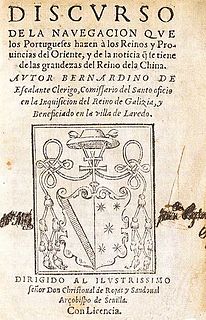 W
WBernardino de Escalante was a Spanish soldier, priest, geographer and a prolific writer. He is best known as the author of the second book on China that was published in Europe, and the first author of such a book to obtain wide circulation outside of Portugal.
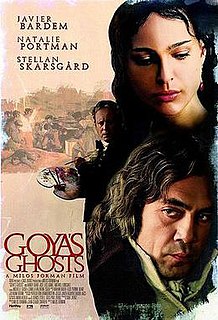 W
WGoya's Ghosts is a 2006 Spanish-American film, directed by Miloš Forman, and written by him and Jean-Claude Carrière. The film stars Javier Bardem, Natalie Portman and Stellan Skarsgård, and was filmed on location in Spain during late 2005. The film was written, produced, and performed in English although it is a Spanish production.
 W
WGrand Inquisitor was the lead official of the Inquisition. The title usually refers to the chief inquisitor of the Spanish Inquisition, even after the reunification of the inquisitions. Secretaries-general of the Roman Inquisition were often styled as Grand Inquisitor but the role and functions were different.
 W
WThe Holy Child of La Guardia is a folk saint in Spanish Roman Catholicism and the subject of a medieval blood libel in the town of La Guardia in the central Spanish province of Toledo.
 W
WThe Inquisition Tribunal, also known as The Court of the Inquisition or The Inquisition Scene, is an 18x29 inch oil-on-panel painting produced by the Spanish artist Francisco Goya between 1812 and 1819. The painting belongs to a series which also includes The Bullfight, The Madhouse and A Procession of Flagellants, all reflecting customs which liberals objected to and wished were abandoned, but their reform was opposed by the absolutist policy of Ferdinand VII of Spain.
 W
WJuan Antonio Llorente, ORE was a Spanish historian.
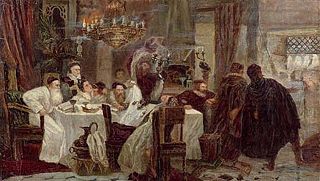 W
WMarranos were Spanish and Portuguese Jews living in the Iberian Peninsula who converted or were forced to convert to Christianity during the Middle Ages, yet continued to practice Judaism in secret.
 W
WGregorio Mayans y Siscar (1699–1781) was a Spanish historian, linguist and writer of the Enlightenment in Spain.
 W
WFrancisco Pacheco del Río was a Spanish painter, best known as the teacher and father-in-law of Diego Velázquez and Alonzo Cano, and for his textbook on painting, entitled Art of Painting, that is an important source for the study of 17th-century practice in Spain. He is described by some as the "Vasari of Seville": vocal and didactic about his theories of painting and thoughts about painters, conventional and uninspired in his executions
 W
WThe Palacio de los Olvidados is a museum in Granada, Spain, dedicated to Inquisition. The museum has a selection of the instruments most used by different inquisitorial, ecclesiastical and civil courts, throughout Europe for torture, public humiliation and capital punishment. This palace also has an exhibition of Interactive Flamenco. With this exhibition you can discover the whole world of flameco in an exclusive space specially designed to experience the different sensations that this art can offer.
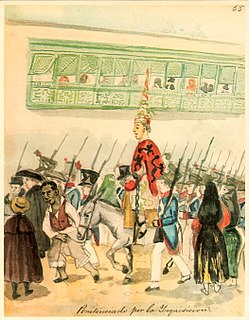 W
WThe Peruvian Inquisition was established on January 9, 1570 and ended in 1820. The Holy Office and tribunal of the Inquisition were located in Lima, the administrative center of the Viceroyalty of Peru.
 W
WThe Reconquista was a period in the history of the Iberian Peninsula of about 780 years between the Umayyad conquest of Hispania in 711, the expansion of the Christian kingdoms throughout Hispania, and the fall of the Nasrid kingdom of Granada in 1492.
 W
WSanbenito was a penitential garment that was used especially during the Spanish Inquisition. It was similar to a scapular, either yellow with red saltires for penitent heretics or black and decorated with devils and flames for impenitent heretics to wear at an auto da fé.
 W
W"The Spanish Inquisition" is a series of sketches in Monty Python's Flying Circus, Series 2 Episode 2, first broadcast 22 September 1970, parodying the real-life Spanish Inquisition. This episode is itself entitled "The Spanish Inquisition". The sketches are notable for their principal catchphrase, "Nobody expects the Spanish Inquisition!", which has become a frequently used quote. The end of the sketch uses music from the composition "Devil's Galop" by Charles Williams. Rewritten audio versions of the sketches were included on Another Monty Python Record in 1971.
 W
WTomás de Torquemada, also anglicized as Thomas of Torquemada, was a Castilian Dominican friar and first Grand Inquisitor in Spain's movement to homogenize religious practices with those of the Catholic Church in the late 15th century, otherwise known as the Spanish Inquisition.